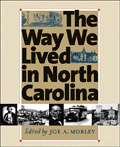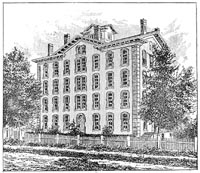
Prison laborers released to the Western North Carolina Railroad, 1915
|



FROM JUBILEE TO JIM CROW . . .
CHAPTER EXCERPTS
The Color Line
 auli Murray flourished in response to opportunities away from home. Yet she also built upon a long North Carolina heritage of black accomplishment and striving. She built on the achievements of those who opened the first schools for black youths and adults after 1865 and who "taught not merely to impart knowledge but to build character and shape the future." She built on the philosophy of uplift and black self-help—of "dogged work and manly striving"—that had taken root in nearly a dozen black colleges founded in the state after the war. She built on the special heritage of Durham, where the values of self-help and racial solidarity were funneled into business enterprise. The "grit and greenback" of Durham's blacks had produced "the Negro Wall Street of America," a downtown block of Parrish Street dotted with black businesses and dominated after 1921 by the six-story skyscraper of the North Carolina Mutual Life Insurance Company. Above all, Pauli Murray built her life of commitment to racial liberation upon a southern black heritage of spiritual strength and political struggle. That striving for independence surged to the surface in the Year of Jubilee and found expression in all-black churches and all-black conventions that the new freedpeople organized after 1865. auli Murray flourished in response to opportunities away from home. Yet she also built upon a long North Carolina heritage of black accomplishment and striving. She built on the achievements of those who opened the first schools for black youths and adults after 1865 and who "taught not merely to impart knowledge but to build character and shape the future." She built on the philosophy of uplift and black self-help—of "dogged work and manly striving"—that had taken root in nearly a dozen black colleges founded in the state after the war. She built on the special heritage of Durham, where the values of self-help and racial solidarity were funneled into business enterprise. The "grit and greenback" of Durham's blacks had produced "the Negro Wall Street of America," a downtown block of Parrish Street dotted with black businesses and dominated after 1921 by the six-story skyscraper of the North Carolina Mutual Life Insurance Company. Above all, Pauli Murray built her life of commitment to racial liberation upon a southern black heritage of spiritual strength and political struggle. That striving for independence surged to the surface in the Year of Jubilee and found expression in all-black churches and all-black conventions that the new freedpeople organized after 1865.

Bishop James W. Hood
|
Independence Halls — From its birth in a brush arbor in Durham in 1869, St. Joseph's AME Church has become one of the leading congregations of that denomination in North Carolina. Its first minister, the Reverend Edian Markham, had been born a slave in 1824 and had escaped bondage by the Underground Railroad. He educated himself in New York and then chose Durham as his first missionary field. The congregation that he formed was first called Union Bethel.
Were it still standing today, the two-story wooden building of the AME Church in Raleigh might be regarded as the Independence Hall of black North Carolinians. In this modest structure, located on a back street just a few blocks from the old State Capitol, black delegates from all over the state declared themselves a "Convention of Freedmen" on 29 September 1865. The 115 men, most slaves just months before, met to find ways to eradicate the legal inequities of the past. They timed their convention to coincide with the assembly of whites who convened blocks away in the state legislative chamber to form a new civil government. For four days they deliberated in the sparsely furnished church, its floor and gallery filled to capacity by 400 delegates, spectators, and reporters. Ever on view behind the pulpit was a lifelike bust of Abraham Lincoln, shrouded in mourning, with the inscription overhead: "With malice toward none, with charity for all, with firmness in the right."


Estey Hall (1874), Shaw University, Raleigh
|
Colleges for Uplift — The philosophy of uplift and a commitment to black self-help took firm root in nearly a dozen black colleges founded in North Carolina after the war. Handsome buildings named for out-of-state benefactors still grace the campuses of Shaw University in Raleigh, Johnson C. Smith University in Charlotte, and Livingstone College in Salisbury. Each of the schools started in small frame or log buildings, and each began with the mission of training young people to become "Christian workers" and educated ministers who could combat the "spirit preachers" of the day.
Two of the schools received their only early support from northern churches and the Freedmen's Bureau and faced serious opposition from native whites. The Reverend Henry Martin Tupper, the Massachusetts Baptist minister who founded Shaw in Raleigh, was threatened by the Ku Klux Klan in the 1860s. Continuing tension and ostracism in the mid-1870s produced teachers who were, in the eyes of one outside observer, the "most forbidding New England type—with whom duty—in all matters—is always a business and never a pleasure." Yet, "the truth is that a less cold & determined set of people would be badgered almost to death & driven away." The first years of the "Freedman's College" in Charlotte—which would become the Biddle Memorial Institute and finally Johnson C. Smith University—were no less trying for the native white ministers who founded the Presbyterian school in 1867. Fellow churchmen forced the ministers to disaffiliate themselves and the school from the southern church. By the time the African Methodist Episcopal Church established Livingstone College in Salisbury in the 1880s, however, white North Carolinians saw the merit of colleges designed to educate black clergy and instruct black youths in both the liberal arts and industrial skills.
Black Business and White Supremacy — The North Carolina Mutual Life Insurance Company Building, which dominates the south side of Parrish Street in downtown Durham—and its gleaming twelve-story successor, a daring architectural pillar of glass and concrete built on the hill that once accommodated the estate of the son of Washington Duke—stand as testimony to black achievement amid adversity. A thousand guests attended the dedication of the Parrish Street office structure in 1921 and celebrated the opening of the building as a monument to "Negro progress."
To a black Durham tobacco worker, the Mutual Building and the black Mechanics and Farmers Bank housed on its first floor were more than symbols. A Mutual insurance policy provided a measure of family protection, and the black bank offered the enterprising man a way to get ahead.
In the broadest sense, the Mutual was descended from a century-old tradition of black fraternal and burial societies, built around the ideas of self-help and moral improvement and organized to provide sickness and burial insurance. With the end of Reconstruction and the waning of the quest for black advancement through civil rights and integration, black self-help and benefit societies mushroomed.

In a fundamental way, the Mutual was founded in response to the reign of terror visited upon North Carolina's blacks during the successful white supremacy campaign of the 1890s. It was in October of 1898, the first year of the terror, that John Merrick of Durham—a black entrepreneur wh owned three white and three black barbershops and who served as the personal barber to Washington Duke—gathered together six other men in skilled trades and professions to lay the basis for the company. In the red-shirted vigilantes who broke up black political rallies and threatened violence to blacks who came to the polls, in the gruesome lynching of a black man between Durham and Chapel Hill, they had seen the handwriting on the wall. Though five of the Mutual's founders had been active in the Republican Party, they concluded that October evening that they must abandon politics and the assertion of their rights. Blacks must instead turn to "education, business and industrial progress," "keep quiet and saw wood," and turn their "attention to making money." In "commercial opportunity" they would "hammer away. The almighty dollar is the magic wand that knocks the bottom out of race prejudice and all the humbugs that fatten on it."
|

